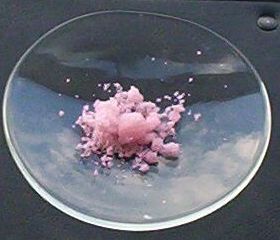Erbium(III) chloride
Chemical compound From Wikipedia, the free encyclopedia
Erbium(III) chloride is a violet solid with the formula ErCl3. It is used in the preparation of erbium metal.
 | |
| Names | |
|---|---|
| IUPAC name
Erbium(III) chloride | |
| Other names
Erbium trichloride | |
| Identifiers | |
| |
3D model (JSmol) |
|
| ChemSpider | |
| ECHA InfoCard | 100.030.337 |
| EC Number |
|
PubChem CID |
|
| UNII | |
CompTox Dashboard (EPA) |
|
| |
| |
| Properties | |
| ErCl3 (anhydrous) ErCl3·6H2O (hexahydrate) | |
| Molar mass | 273.62 g/mol (anhydrous) 381.71 g/mol (hexahydrate) |
| Appearance | violet hygroscopic monoclinic crystals (anhydrous) pink hygroscopic crystals (hexahydrate) |
| Density | 4.1 g/cm3 (anhydrous) |
| Melting point | 776 °C (1,429 °F; 1,049 K) (anhydrous) decomposes (hexahydrate) |
| Boiling point | 1,500 °C (2,730 °F; 1,770 K) |
| soluble in water (anhydrous) slightly soluble in ethanol (hexahydrate)[1] | |
| Structure[2] | |
| monoclinic | |
| C2/m, No. 12 | |
a = 6.80 Å, b = 11.79 Å, c = 6.39 Å α = 90°, β = 110.7°, γ = 90° | |
Lattice volume (V) |
479 Å3 |
Formula units (Z) |
4 |
| Related compounds | |
Other anions |
Erbium(III) oxide |
Other cations |
Holmium(III) chloride, Thulium(III) chloride |
Except where otherwise noted, data are given for materials in their standard state (at 25 °C [77 °F], 100 kPa).
| |
Preparation
Anhydrous erbium(III) chloride can be produced by the ammonium chloride route.[3][4][5] In the first step, erbium(III) oxide is heated with ammonium chloride to produce the ammonium salt of the pentachloride:
- Er2O3 + 10 [NH4]Cl → 2 [NH4]2ErCl5 + 6 H2O + 6 NH3
In the second step, the ammonium chloride salt is converted to the trichloride by heating in a vacuum at 350-400 °C:
- [NH4]2ErCl5 → ErCl3 + 2 HCl + 2 NH3
Structural data
Erbium(III) chloride forms crystals of the AlCl3 type, with monoclinic crystals and the point group C2/m.[2]
Erbium(III) chloride hexahydrate also forms monoclinic crystals with the point group of P2/n (P2/c) - C42h. In this compound, erbium is octa-coordinated to form [Er(H2O)6Cl2]+ ions with the isolated Cl− completing the structure.[6]
Optical properties
Erbium(III) chloride solutions show a negative nonlinear absorption effect.[7][clarification needed]
Catalytic properties
The use of erbium(III) chloride as a catalyst has been demonstrated in the acylation of alcohols and phenols[8] and in an amine functionalisation of furfural.[9] It is a catalyst for Friedel–Crafts-type reactions, and can be used in place of cerium(III) chloride for Luche reductions.[10]
References
Wikiwand - on
Seamless Wikipedia browsing. On steroids.